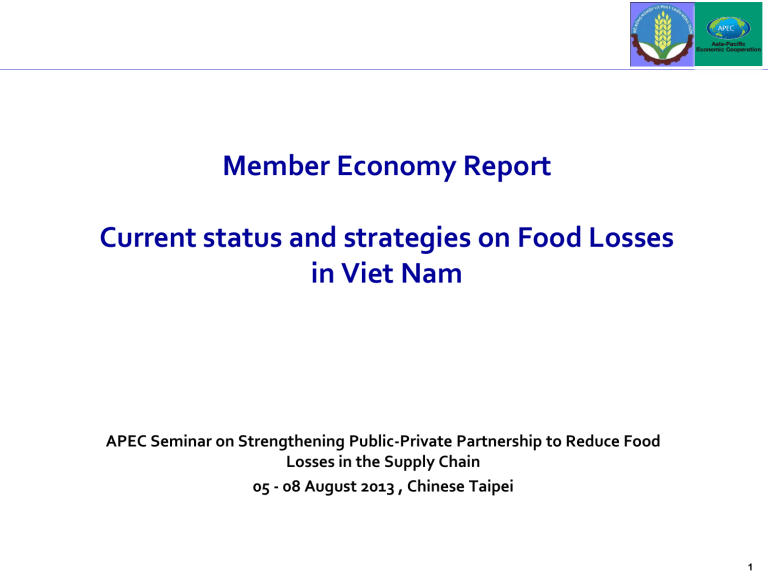Member Economy Voluntary Reports—Vietnam

Member Economy Report
Current status and strategies on Food Losses in Viet Nam
APEC Seminar on Strengthening Public-Private Partnership to Reduce Food
Losses in the Supply Chain
05 - 08 August 2013 , Chinese Taipei
1
Current Status of Post-harvest Losses in Viet Nam
Agriculture-based economy: rice is staple food with the total rice growing area of 7.7 million ha and total food production of c.a. 48.5 million tons (2012); Population: 87 million, 70% of which living in rural areas.
Agriculture sector also key to sustain growth and reduce poverty: 21,65% of GDP in 2012, contributing around 24% of export revenue.
Post-harvest losses are reported to be 1-2% of GDP varying between commodities and
seasons: post-harvest losses of rice (13.7%), other food grains (10%), tubers and roots (10-20%), fruit and vegetables (20-30%);
Factors contributing to post-harvest losses: cutting, threshing, drying, storage, pests and diseases, transport and milling
Stage of production
Harvest/cutting
Threshing
Drying
Storage
Milling, processing
Rice (%)
1.3 - 2.9
1.4 - 2.3
1.6 - 1.9
2.6 - 2.9
2.2 - 3.3
Maize (%)
-
3 - 4
5
10
2.2 - 3.3
2
Current Status of Post-harvest Losses in Viet Nam
Average post-harvest losses of rice in Viet Nam:
Stage of production
Harvest/cutting
Threshing
Drying, cleaning
Transport
Storage
Milling
Total
Losses (%)
1.3 - 1.7
1.4 - 1.8
1.9 - 2.1
1.2 - 1.5
3.2 - 3.9
4.5 - 5.0
13 - 16
3
Challenges to Food Loss Reduction
Policy constraints:
Lack of attractive policy and incentives to promote investment and research in addressing postharvest losses.
Resource constraints:
Financial gap serves as a critical barrier
Human resources: limited staff with qualification and experiences.
Technology: lack of appropriate technology to address research and development of post-harvest losses reduction.
Limited capabilities and involvement of farmers:
Production dominated by small farmers with limited access to resources and technology.
Farmers role limited to field operation with little value addition
Lack of farmer incentives to adopt new technologies
4
Policy and strategy recommendations for Reducing Food Losses
Conducting comprehensive research and studies for food losses in food system: variety improvement, post-harvest technology, utilization and marketing
Support to institutional and policy development: strengthening institutional and policy framework to enhance agricultural production, agribusiness sector, infrastructure and small scale enterprises
Providing a favourable conditions for the delivery of local agricultural services: pesticide fertilizer use, storage (cold and warehouse), transport, marketing…
Establishing goals or targets for food loss reduction for a range of target audience (education campaigns for producers, growers, processors, consumers).
Developing markets for different grades and types of agricultural products
Strategies:
Focus on strengthening Small and Medium sized Enterprises (SME).
Private and Public partnership: maximum leverage of private investments with diverse range of revenues and profitability
Integrated approach: Production under quality control and management for domestic market and export.
Focus on boosting processed goods rather than export of raw materials.
Objective to engage and enable smallholder producers and thus allowing the whole sector to advance.
5











